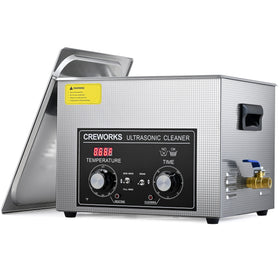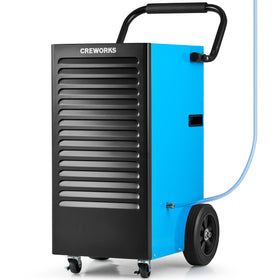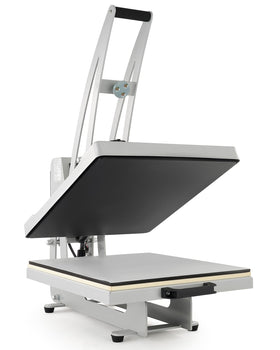With over 10000+ orders
With over 10000+ orders
Many people using ultrasonic cleaners don't realize that improper use can lead to skin irritation, tissue damage, or even chemical burns. Ultrasonic cleaners can indeed hurt you if used incorrectly - but the risks aren't what most people think. While the ultrasonic vibrations themselves rarely cause direct harm, it's the combination of energized cleaning solutions, heat buildup, and chemical exposure that creates real safety concerns.
After working with these devices in both professional and home settings, we've identified exactly what can cause injury and, more importantly, how to prevent it. Let's explore the actual risks of ultrasonic cleaners and the proper safety measures that experienced operators use to protect themselves.

The safety concerns with ultrasonic cleaners go beyond just the ultrasonic waves. When the high-frequency vibrations agitate cleaning solutions, three distinct safety risks emerge that many users overlook:
The intense pressure created by cavitation can irritate your skin and damage underlying tissue. While brief exposure might only cause tingling, extended contact often leads to more serious irritation and potential tissue injury.
Standard ultrasonic cleaning solutions become more aggressive when energized by ultrasonic waves. OSHA's industrial hygiene guidelines warn that ultrasonic energy makes cleaning solutions more reactive. This means even mild cleaners can become hazardous when energized. Different solutions have different risks - industrial cleaners especially need careful handling based on manufacturer safety data sheets.
Many users don't realize that ultrasonic cleaning generates significant heat over time. Solutions can reach temperatures high enough to cause burns, especially during extended cleaning cycles. The combination of hot solution and ultrasonic energy creates an increased risk of tissue damage.
Every ultrasonic cleaner needs a safe workspace. Start by finding a spot with good airflow. This helps clear any vapors that might build up during cleaning.
Keep your safety gear close by. You'll need gloves and eye protection within easy reach. Place your cleaner on a flat, stable surface. Make sure you can easily move around all sides of the unit.
Safety matters most when your ultrasonic cleaner is running. Never put your hands into the unit while it's on. The same action that cleans your items can harm your skin.
Always use the basket that comes with your cleaner. This keeps your hands away from the cleaning solution. Watch the temperature if you're running long cleaning cycles. Hot solution can cause burns.
Keep the lid closed while cleaning. This stops vapors from spreading and protects you from accidental splashes.

Safety features matter when picking an ultrasonic cleaner. Creworks offers a range of sizes to match your needs - from small 2L units to large 30L models. Every cleaner in their lineup comes with important safety elements. You get stainless steel construction that won't leak. Non-skid feet keep the unit stable on your counter. The lid seals tight to keep vapors inside.
Simple controls let you set exact times and temperatures. You never have to touch the cleaning solution - each unit includes a protective basket. New users find the smaller units easy to use. Professional users appreciate the safety features on larger models, like automatic shutoff. Whether you're just starting or have years of experience, these cleaners put safety first.

Safety requirements vary depending on your setting. Professional jewelry cleaning requires different precautions than industrial parts cleaning. Here's what you need to know for different environments:
Focus on proper ventilation and basic protective equipment. Keep children and pets away from the cleaning area. Store solutions securely when not in use.
Follow OSHA guidelines for chemical handling and respiratory protection. Maintain proper documentation of cleaning solutions and safety procedures. Implement proper waste disposal protocols.
Install proper ventilation systems. Provide comprehensive staff training on equipment operation and emergency procedures. Maintain detailed logs of maintenance and safety checks.
If you have a pacemaker or other medical implant, you need to be extra careful. Ultrasonic cleaners create magnetic fields that can mess with medical devices. These fields reach beyond just the cleaning tank itself, so keeping your distance matters.
Talk to your doctor about using an ultrasonic cleaner safely. They can tell you how far to stay away from the unit and what warning signs to watch for with your specific device.
Experienced users know what to watch for. If your cleaner starts making strange noises or vibrating differently than usual, something's wrong. These problems can create spots in your cleaning solution that get dangerously hot or become too aggressive.
Keep an eye on your cleaning solution too. If it changes color, gets cloudy, or starts smelling different, it's time to change it. Old or contaminated solutions are more likely to cause problems.

Most safety problems develop slowly as equipment wears out. A quick safety check before each use prevents accidents. Look at your unit's seals and lid - even small leaks can spray hot, energized solution on your skin or release harmful vapors into your workspace.
Test your emergency stop button regularly - you need to know it'll work if something goes wrong. Check your safety gear just as carefully. Torn gloves or scratched safety glasses won't protect you properly. Replace any worn-out safety equipment before it fails.
These safety steps come from real experience preventing injuries. When you understand what can actually hurt you and take the right precautions, you can focus on getting your items clean without worrying about getting hurt.
Putting your hand in an operating ultrasonic cleaner causes immediate discomfort and can damage your skin and tissue. The combination of hot cleaning solution, aggressive chemicals, and ultrasonic energy can lead to burns and tissue injury.
No, ultrasonic cleaners don't give off harmful radiation. They create magnetic fields that can interfere with medical devices like pacemakers, but they don't produce radiation that harms healthy users when operated properly.
While ultrasonic cleaners operate above human hearing range, some units may produce audible noise. Keep the lid closed during operation and maintain proper distance to protect your hearing. The main safety concerns are actually from solution contact, not sound.
Wearing gloves and goggles helps protect your skin and eyes from the cleaning solution activated by ultrasonic waves. These solutions can be more corrosive and hotter than usual, so direct contact might cause irritation or burns. The protective gear also helps prevent accidental splashes that could harm you during cleaning.
You should change the cleaning solution when it starts to look cloudy, change color, or develop a smell. This means it’s contaminated or no longer effective.












Leave a comment